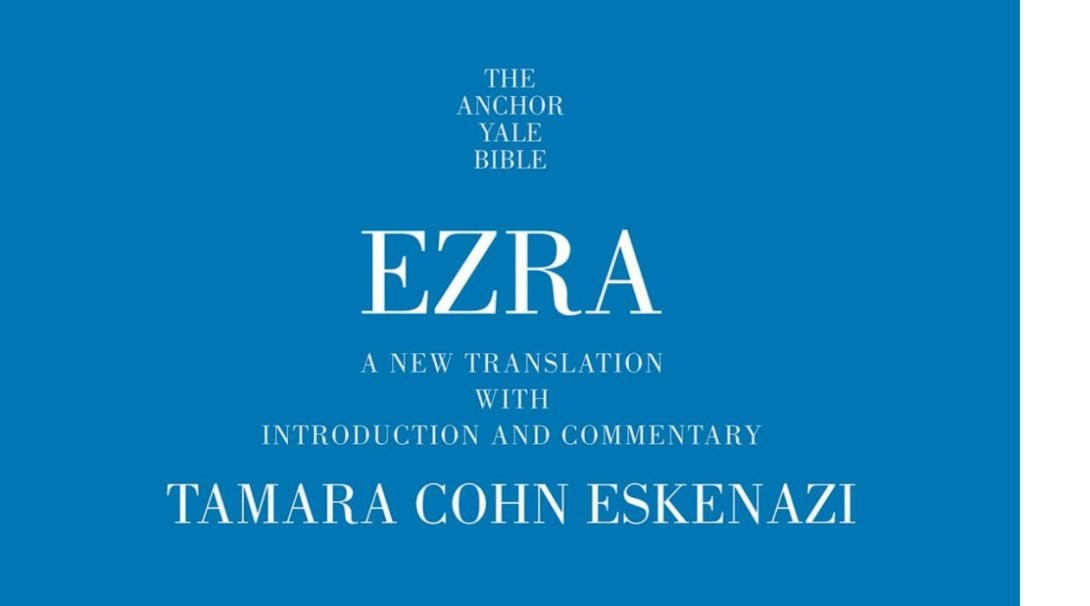Giovanna Czander’s review of Tamara Cohn Eskenazi, Ezra: A New Translation with Introduction and Commentary, Anchor Yale Bible, 2023.

Ezra is a relatively unknown character among Catholics and not surprisingly so. Ezra (which in early manuscripts was a single book with Nehemiah) was never read during liturgies before the Second Vatican Council. According to the new Lectionary of the Catholic Church, today only twenty-one of Ezra’s 280 total verses are read at Mass and none during major feasts.
Tamara Cohn Eskenazi’s new book on Ezra is a scholarly work and helpful in introducing a little-known figure, at least among Catholics. Who was Ezra? What are we missing by neglecting this book? What is the message (or messages) in the book?
The historical context for Ezra is the return of the Israelites (more precisely, Judeans from the South) from Babylonian exile. The exile started with a two-staged deportation in 597 and 587 BCE and the destruction of the Temple in Jerusalem built by King Solomon. The exile began to end when king Cyrus and the Persians defeated the Babylonians in 538. Cyrus allowed and even encouraged the Israelites to return to the land of Judah and rebuild the Temple (see Ezra 1).
Ezra is defined as a “priest and scribe,” though he never seems to have performed cultic functions. He was rather a leader of the returning Judeans. Ezra’s role, among others, was to promote and reinterpret the Torah of Moses in changed times and circumstances.
The book of Ezra is about new beginnings and change. What does it mean to live holiness (in the sense of “belonging to God”) after the exile? What are the boundaries that contribute to maintaining the identity of Israel as the people of God?
When Ezra and the exiles arrive in Jerusalem, he is informed that many Israelites have married “foreign women.” According to Cohn Eskenazi, these women are singled out not because of ethnicity, but because they are holding on to worship of other gods in addition to the God of Israel. This group most likely includes Israelite women who remained in Judah during the exile (since not everyone had been taken to Babylon).
Ezra is devastated at the news because these marriages and what they entail affect the identity of Israel as God’s people. What to do? Ezra “takes onto himself” the sins of the people, tears his clothes as a mourning sign, fasts, and sits in penance. His prayer in chapter 9 is moving. After seeing his reaction, the leaders of the people beg him to intervene and reestablish their relationship with God. Ezra then creates teams of leaders to give an account of the names of those who have married “foreign women.” This is done orderly, and only four men (all priests) separate themselves from their wives and children. Nothing is said about the others. What for many scholars has seemed a disturbing mass divorce is, according to Cohn Eskenazi, indication of a practice for the future. Endogamy or marriage within the same people will be the change required in order to preserve the identity of Israel.
The book of Ezra is also about leadership. Cohn Eskenazi points out Ezra’s unique leadership style. Although invested of authority and power, he does not force people to obey, is not a tyrant. When faced with the “foreign wives” issue, Ezra could have proclaimed a decree and punished. Instead, he waited for the people to ask him to do something.
Ezra is about identity, both personal and communal. How to remain true to oneself is one of the enduring questions both for individuals and communities. The question became even more burning for the Israelite community in exile in Babylon and maintained its relevance when the exiles returned to Jerusalem and the promised land after exile. Who belongs and who doesn’t? What defines us? What is negotiable? These are questions that constantly confront religious groups. What can be changed? What needs to stay the same?
Cohn Eskenazi offers an interesting and inclusive view: ethnicity is not sufficient to establish identity as the people of God. Behavior and choices also matter. For example, “The people of the land,” a phrase that in pre-exilic times was used mostly to characterize non-Israelite inhabitants of the land of Canaan, in Ezra qualifies also Israelites that have absorbed practices from the locals, practices that according to biblical standards are considered idolatrous. One “becomes” part of the “people of the land” based on choices and behavior.
Cohn Eskenazi’s approach is well-balanced, cautious where it needs to be, extensive both in depth and breath. And she makes clear that Ezra has a message for us today, Jewish or not.












